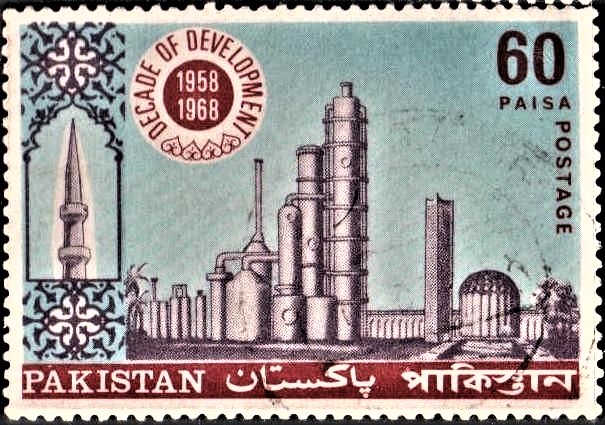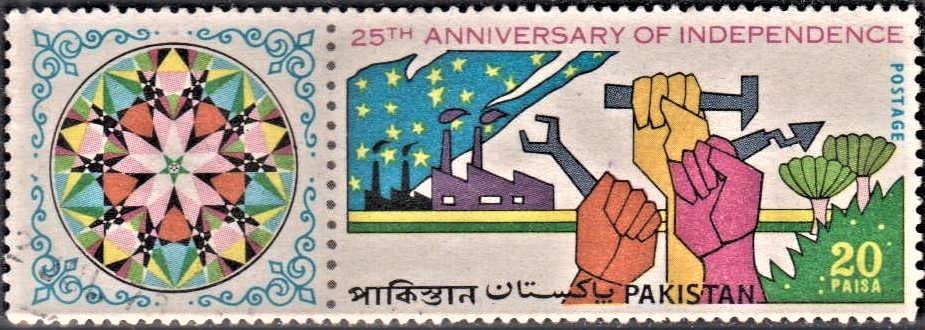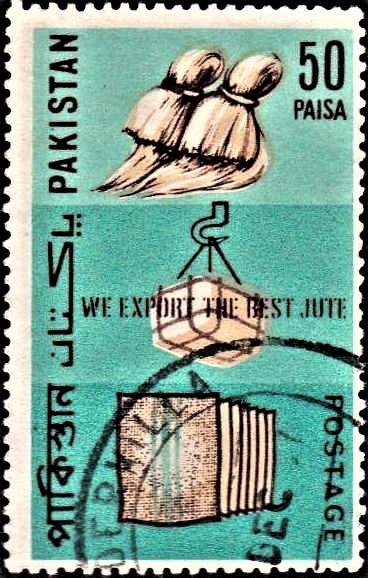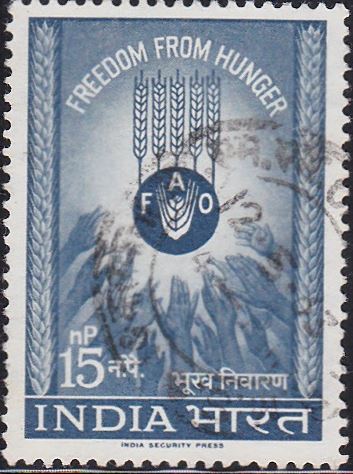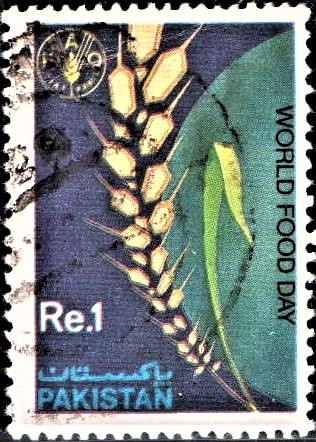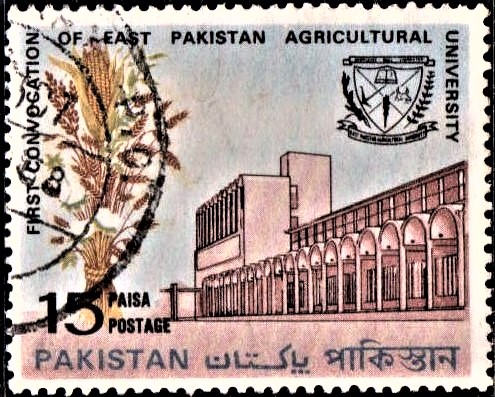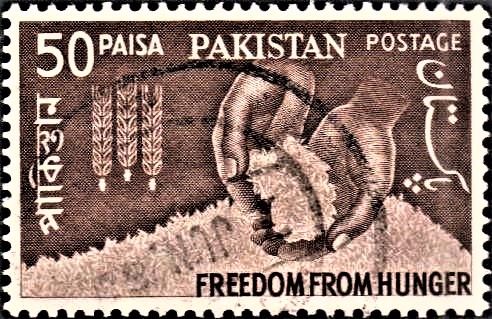
Pakistan on Freedom from Hunger 1963
Complete set of 2 nos. of commemorative postage stamp on the Freedom from Hunger Campaign:
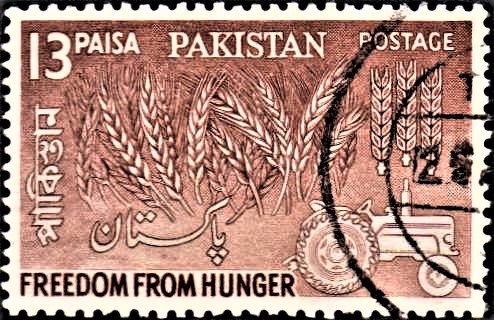
 Issued by Pakistan
Issued by Pakistan
Issued on Mar 21, 1963
Issued for : The Pakistan Post Office is issuing this set of stamps for bringing out an immediate comprehension of the problem of world hunger and for making an important psychological contribution in the attack thereon.
Design : The designs have been prepared by the Pakistan Security Printing Corporation Ltd., Karachi under the guidance of the Director-General, Pakistan Post Office.
13-PAISA: Crop of wheat is shown with a tractor in the right hand bottom corner symbolising mechanised farming for greater crop yield. At the bottom on the left side appears the slogan “FREEDOM FROM HUNGER”. Above the tractor is the symbol of F.A.O., at the top are the words “13-Paisa”, “PAKISTAN” and “Postage” in English. PAKISTAN in Bengali appears in the left side and in Urdu at the bottom.
50-PAISA: Human hands have been shown lifting rice from a heap and the slogan “FREEDOM FROM HUNGER” appears at the bottom right. The symbol of F.A.O. appears to the left of the centre of the stamp. At the top are the words “50-Paisa”, “PAKISTAN” and “Postage” in English. “PAKISTAN” in Urdu appears on the right side and in Bengali on the left side.
Type : Stamps, Postal Used
Denomination : 13 & 50 Paisa
Colour :
13-Paisa: Reddish Brown
50-Paisa: Dark Brown
Size of Stamp : 41 x 26 mm.
Size of Print : 38 x 23 mm.
Perforation : 14 x 12½ (c)
Quantities Printed :
13–Paisa: 10,00,000
50–Paisa: 5,00,000
No. of stamps in each sheet : 80
Process of Printing : Recess
Printers : The Pakistan Security Printing Corporation Ltd., Karachi
About :
- At present one out of every two people in the world suffers from hunger, some 300-500 million from undernutrition and some 1,000-1,200 million from malnutrition. With not enough to eat today, nor an adequate food supply for tomorrow, a man’s strength is sapped, his mind degraded and his spirit broken. A hungry or undernourished man neither works with energy or skill, nor enjoys the full benefit of his work that a properly nourished man does.
- The Food and Agriculture Organisation (F.A.O.), a specialized agency of the U.N.O., was set up in 1945 to help the peoples of the world in their continuing fight against hunger and malnutrition. Its member countries numbered 42 in 1945 and now number 88. F.A.O. has three pronged activities. It collects, analyses and disseminates basic information about food and agriculture, through its international technical staff. It provides direct technical advice and aid to member countries; and it promotes co-operative action towards solving general and regional problems, such as surplus and deficit in agricultural commodities.
- Pakistan Government has given active support to the Campaign that from the time the idea was bring mooted out. The Campaign was officially inaugurated in Pakistan on 1st July, 1960, by the Food and Agriculture Minister. The Government of Pakistan made a cash contribution of Rs. 50,000 towards the Hunger Campaign Trust Fund; and has also set up a National Freedom From Hunger Campaign Committee to help Government’s participation in the Campaign.
- Pakistan’s economy is still a great deal dependent upon agriculture. Wheat and rice are staple food. The country’s Second Five–Year Plan has laid special emphasis upon development of agriculture. Besides bringing about agrarian reforms designed basically to boost up agricultural production and construction of dams for irrigating more land to be brought under cultivation, efforts are underway for training the producers in advanced methods of cultivation and to encourage them in greater use of chemical fertilisers.
- Two Agricultural Universities, one at Mymensingh (East–Pakistan) and another at Lyallpur (West–Pakistan) and important research institutes at Peshawar, Lyallpur and Tandojam, have been set up. In order to translate into practice the findings of the Food and Agriculture Commission, Agricultural Development Bank and Corporations have been set up to organize agricultural supplies and to make them available in adequate quantities at the Union level, through Corporations, where possible, and to develop projects for enabling the farmers to change over to scientific agriculture and develop better market economy. Coordination of allied research has also been provided by an Agricultural Research Council, which investigates the causes of low acreage and suggests methods of increasing the output. The Government have continued the policy of subsidizing fertilizers, partly subsidizing seeds and providing facilities of plant protection through Government operated services. Introduction of a Model Scheme for rice cultivation has proved very encouraging in East-Pakistan where in the selected Sub-Division the production has increased to the tune of 48 per cent.
- Water-logging and Salinity, however, continues to be a serious menace to the agricultural development of West-Pakistan, where out of 23 million acres of irrigated land nearly 7 million acres have been affected in various degrees by salts and water-logging, and nearly 3 million acres have gone out of cultivation as a result of this still unsolved problem, which is throwing out of cultivation about 100,000 acres annually. Lately, U.S. Scientific Mission headed by Dr. Weisner studied this problem in Pakistan. The report is under examination.
- Pakistan’s resources in respect of fishing are pretty large. The Karachi Fish Harbour alone handles a daily average of over 70 tons of fish valuing Rs. 100,000. Annual production of fish during 1959-60 was estimated at 290 thousand tons. It increased to 304 thousand tons in 1960 and 318 thousand tons in 1961. Fish industry possesses large potential for further development. A programme of mechanisation of craft is receiving attention. A scheme of one exploratory fishing is also in hand in collaboration with the Japanese Government.
- In 1961 and over the next several years, supreme effort will be needed by Government, public institutions, and the public at large to assist the world’s under privileged peoples to raise their living standards. One of such efforts is the 1960-1965 Freedom From Hunger Campaign, led by the F.A.O. In March 1963, this Campaign reaches its mid-point and around the equinox of March 21, a World Freedom From Hunger Week is being held, which receives excessive gesture of International solidarity where it is added impetus to the national campaigns as they enter their second stage.
- With the compliments of the Director-General, Pakistan Post Office, Karachi.


